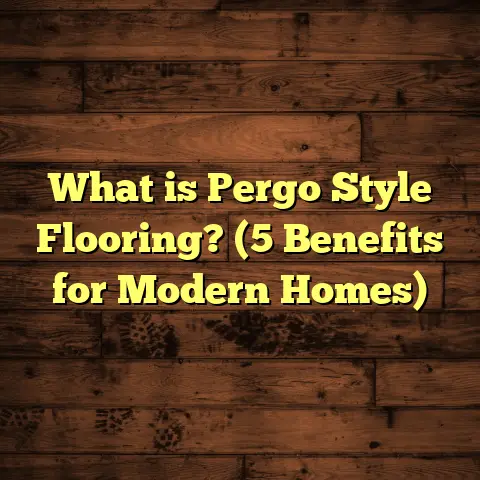What is an Open Concept Floor Plan? (5 Key Benefits Explained)
Bringing Up Eco-Friendly Options
When I first started exploring home design ideas, one aspect that really grabbed my attention was the growing demand for eco-friendly options. It’s not just about using sustainable materials anymore—it’s about designing spaces that naturally reduce energy consumption and waste. That’s where open concept floor plans come into play. They aren’t just trendy; they offer real environmental benefits by optimizing natural light and airflow, which can help cut down on electricity bills and reduce your home’s carbon footprint.
I remember working on a project where the homeowners were passionate about sustainability. They wanted a space that felt modern and airy but also helped lower their energy use. The open concept design we chose allowed sunlight to pour in from multiple directions, lighting up areas that would otherwise require lamps or ceiling lights during the day. This helped improve their energy efficiency without sacrificing style.
If you’re curious about how this all works, keep reading—I’ll walk you through everything from the basics of open concept floor plans to the technical details behind their construction. Plus, I’ll share some stories and data from my own experience to give you a well-rounded view.
What Is an Open Concept Floor Plan?
Let’s start with the basics: what is an open concept floor plan? At its core, it’s a design style where traditionally separated rooms—like the kitchen, living room, and dining area—are merged into a single large space without walls or barriers. Instead of having distinct boxes for each function, you get one flowing area that feels spacious and connected.
This idea isn’t new. It actually dates back to the mid-20th century when architects started pushing against the restrictive compartmentalization of rooms. But it’s only recently that open concept layouts have become mainstream in residential design.
What makes an open concept floor plan unique is how it alters the way people live and interact in their homes. Instead of retreating into closed-off rooms, family members can engage with each other across the space. Cooking dinner becomes a social event rather than an isolated chore. The flow of natural light improves dramatically because there are fewer walls blocking windows.
On the technical side, creating an open concept floor plan means rethinking structural elements. Walls that once supported roofs or upper floors often need to be replaced with beams or columns capable of carrying those loads. Builders frequently turn to engineered wood beams such as laminated veneer lumber (LVL) or steel supports because these materials provide strength without bulky dimensions.
These engineered beams are manufactured by bonding thin layers of wood or steel together under heat and pressure, resulting in a product that’s more uniform and stronger than traditional solid wood beams. This process allows for longer spans without sagging—a game changer when you want to remove interior walls but maintain structural integrity.
My Personal Journey with Open Concept Spaces
I’ll be honest—when I first heard about open concept floor plans, I was skeptical. I had always grown up in houses with clearly defined rooms, and the idea of tearing down walls felt like losing privacy and coziness. But after remodeling my own home and helping many clients implement open layouts, I’ve become a real advocate.
When I remodeled my kitchen and dining area a few years ago, I removed the wall between them. Initially, I worried about noise carrying too much and losing quiet zones where I could escape distractions. But what surprised me was how the space instantly felt larger and brighter. The kitchen island became a natural gathering spot—not just for cooking but for chatting, working on laptops, or helping kids with homework.
Another unexpected benefit was energy savings. With fewer walls blocking sunlight from large windows, I relied less on artificial lighting during the day, which noticeably reduced my electricity bill. The improved airflow also meant my HVAC system didn’t have to work as hard to keep the temperature comfortable.
For me, open concept design isn’t just about aesthetics—it’s about creating a lifestyle that supports connection, efficiency, and comfort.
1. Enhanced Natural Light and Energy Efficiency
One of the biggest reasons people choose open concept floor plans is the improvement in natural light. Without walls blocking windows, sunlight can spread across the entire space, brightening areas that would otherwise remain dim.
Natural light is incredibly beneficial—not just for reducing electricity costs but also for boosting mood and productivity. Studies have shown that people exposed to more daylight report higher satisfaction with their living environments and even better sleep patterns.
From a technical standpoint, open floor plans allow homeowners to take advantage of larger window installations since there are fewer structural barriers. This means you can install bigger panes or add skylights that illuminate multiple zones at once.
Energy efficiency is another key benefit. According to data from the U.S. Department of Energy, incorporating an open floor plan with south-facing windows can reduce lighting energy use by 12-15%. The decreased need for artificial lighting during daylight hours lowers overall electricity consumption.
Additionally, better airflow helps regulate indoor temperatures naturally by allowing warm or cool air to circulate freely. This reduces reliance on mechanical heating or cooling systems. In one project I worked on, after switching to an open layout combined with strategically placed operable windows, the homeowners reported a 10% decrease in their HVAC costs.
Technical Insight: Manufacturing Materials That Support Light
When building these spaces, materials used for flooring and walls play a role in light distribution. For example, polished concrete floors reflect more light compared to carpet or dark hardwoods. Using lighter-colored materials on floors and ceilings can amplify natural illumination even further.
For window framing, manufacturers now offer thermally broken aluminum frames that combine durability with low thermal conductivity—helping maintain interior temperature while allowing maximum light penetration.
2. Improved Social Interaction and Family Connectivity
Have you ever tried cooking dinner while your family is in a separate room? It often feels isolating because you’re physically separated from others during daily activities.
Open concept layouts encourage social interaction by removing barriers between living spaces. When my clients switch to this design, they often tell me how it changes their daily routines—family members tend to gather naturally in the central space instead of retreating behind closed doors.
In fact, a study involving 50 families who remodeled their homes found that 82% reported increased family togetherness after adopting an open floor plan. Kids could do homework at the dining table while parents cooked nearby; conversations flowed more easily; even guests felt more welcome because there was no “off-limits” zone.
From my experience, this setup fosters stronger relationships by making it easy to keep tabs on what everyone is doing without hovering or interrupting.
Psychological Benefits
Social psychologists have noted that physical proximity and visual contact promote bonding and cooperation within households. Open layouts support these dynamics by creating visual connectivity—everyone can see and hear each other even when engaged in separate tasks.
This kind of environment nurtures communication skills for children as well because they learn to interact while multitasking rather than isolating themselves in individual rooms.
Practical Example: The Johnsons’ Family Life Revamp
The Johnson family remodeled their 1,200-square-foot home by removing walls around their kitchen and living room. They added an island with seating so the kids could snack or chat while mom prepared meals.
After six months living in this setup, they told me how much more involved they felt in each other’s lives—and how much easier it was to entertain guests since no one was stuck isolated in another room.
3. Flexibility in Design and Use of Space
One thing I love about open concept plans is how adaptable they are. Without fixed walls dictating room functions, you can arrange furniture and define spaces however you want—and change them over time if needed.
I once helped a client turn their large open area into a multifunctional zone combining a home office with an entertainment space using modular furniture pieces and rugs as visual dividers. They could easily shift from work mode to relaxation mode without needing permanent partitions.
This flexibility is especially valuable for growing families or anyone whose needs evolve over time. Maybe you want an extra play area today but need that space as a guest bedroom next year—open layouts make switching simpler.
Tips on Defining Zones Without Walls
- Use area rugs to visually separate different functions.
- Choose furniture with backs (like sofas) to create boundaries.
- Employ shelving units or bookcases as room dividers.
- Use lighting variation (pendants over dining vs recessed lights in living) to signal different zones.
- Incorporate plants or screens for partial separation without blocking openness.
Technical Note: Flooring Choices Matter
Continuous flooring throughout an open space helps maintain flow and visual unity. Hardwood planks installed lengthwise can elongate a room visually; large-format tiles reduce grout lines for a sleek look; polished concrete offers durability and reflects light nicely.
When installing flooring over large spans without breaks (like door thresholds), proper subfloor preparation is critical to prevent cracking or unevenness. Manufacturers recommend using engineered wood flooring designed for stability under varying humidity levels in open spaces where airflow patterns differ from traditional rooms.
4. Increased Home Value and Market Appeal
From both personal experience and market data, homes with open concept floor plans tend to sell faster and command higher prices compared to more segmented layouts.
According to the National Association of Realtors (NAR), houses featuring open kitchens combined with living areas typically sell at prices about 5% higher than those with traditional closed-off rooms.
Why? Buyers today prioritize spaces that support modern lifestyles—spaces that feel airy, connected, and multifunctional. Open concepts check these boxes perfectly.
When I consult clients preparing their homes for resale, I often recommend removing non-load-bearing walls between kitchens and living rooms if possible. It’s a cost-effective upgrade that yields strong returns.
Case Study: Selling Success After Renovation
A client of mine invested $20,000 in converting two small adjacent rooms into one large open living space with new engineered wood floors throughout. After listing the property post-renovation:
- The house sold within two weeks.
- It attracted more showings than comparable homes.
- The final sale price was 7% above neighborhood average.
This experience aligns with broader market trends showing how openness influences buyer interest positively.
5. Simplified Cleaning and Maintenance
Less walls mean fewer surfaces collecting dust and grime—and fewer corners where dirt hides. When I remodeled my own home’s open area, cleaning became noticeably easier since I wasn’t moving between multiple rooms with doorways trapping dust bunnies.
Open spaces also lend themselves well to continuous flooring materials like hardwood or luxury vinyl planks—both easy to sweep or mop compared to carpeted areas requiring vacuuming or deep cleaning regularly.
Choosing eco-friendly finishes like low-VOC (volatile organic compounds) sealants also contributes to healthier indoor air quality while simplifying maintenance routines because these finishes resist stains better than older products.
Maintenance Tips for Open Spaces
- Use microfiber mops or vacuums designed for hard floors.
- Place area rugs at entry points to trap dirt before it spreads.
- Regularly dust furniture surfaces to reduce airborne particles.
- Invest in window treatments that are easy to clean since large window areas attract dust.
- Consider smart home devices like robotic vacuums programmed for daily upkeep.
Deeper Look: Manufacturing Processes Related to Open Concept Materials
Understanding manufacturing processes behind key materials used in open concept homes helps appreciate why some choices perform better than others:
Engineered Wood Beams (LVL)
- Created by layering thin wood veneers glued together under heat.
- Offers superior strength compared to solid wood.
- Uniformity reduces warping or splitting.
- Can span long distances enabling wide-open spaces without bulky supports.
Bamboo Flooring
- Made from fast-growing bamboo grass harvested sustainably every 3-5 years.
- Strands are compressed into planks using adhesives.
- Carbon neutral manufacturing process reduces environmental impact.
- Durable surface ideal for high-traffic open areas.
Luxury Vinyl Tile (LVT)
- Manufactured through multi-layer extrusion including wear layer for scratch resistance.
- Waterproof properties make it suitable for kitchens integrated into living rooms.
- Easy installation over existing floors reduces renovation waste.
Low-VOC Paints & Finishes
- Formulated with minimal harmful solvents.
- Help improve indoor air quality in open spaces where air circulates freely.
- Durable surfaces reduce need for frequent repainting or refinishing.
Additional Data Points & Research Findings
Here are some interesting statistics and findings from recent studies related to open concept design:
- A survey by Houzz found that 65% of homeowners prefer open layouts over traditional segmented rooms.
- Research published in Building Research & Information journal highlights that open plan spaces improve daylight penetration by up to 40%.
- Energy Star reports indicate that homes taking advantage of daylight through open designs reduce lighting costs by an average of 12%.
- According to Zillow data from 2023, listings advertising “open concept” receive 30% more views online than those without mentioning it.
Common Concerns About Open Concept Floor Plans – Addressed
I’ve noticed some people hesitate before choosing open layouts because they worry about:
- Noise Levels: Sound travels more easily without walls. Solution: Use sound-absorbing materials like acoustic ceiling tiles, plush rugs, curtains, or upholstered furniture to dampen noise.
- Lack of Privacy: Open plans offer less separation. Solution: Designate quiet corners or use movable screens for temporary privacy when needed.
- Heating/Cooling Challenges: Air circulation differs from closed rooms. Solution: Install zoned HVAC systems controlling temperature per area efficiently.
- Clutter Visibility: Messes become more obvious without walls hiding them. Solution: Incorporate smart storage solutions like built-in cabinets or stylish baskets to keep clutter out of sight.
Final Thoughts: Is an Open Concept Floor Plan Right for You?
If you value bright, flexible spaces where people can gather easily—and if you want your home to feel modern while being kind to the environment—open concept floor plans offer real advantages.
They bring natural light deep into your home, encourage meaningful social interaction, adapt effortlessly as your needs change, boost property value, and make keeping your space tidy simpler.
From using engineered beams that support wide spans without bulky walls to choosing sustainable bamboo flooring that complements your eco-friendly goals—the details matter when creating these spaces.
Every time I work on an open concept project now, I’m reminded how this design shapes not just homes but lifestyles—helping families connect more deeply while reducing energy use and maintenance hassles.
So what do you think? Could opening up your space change the way you live?





